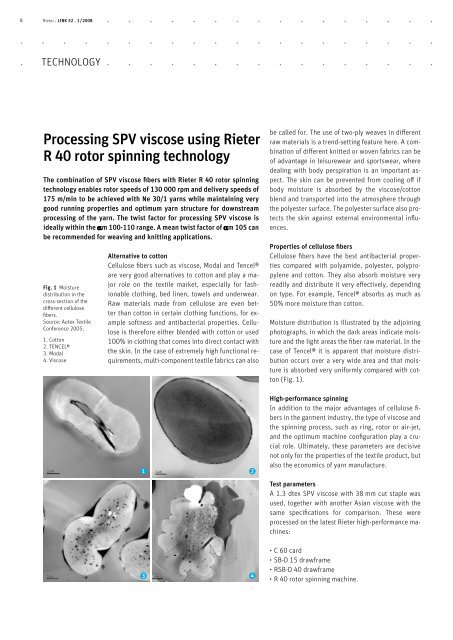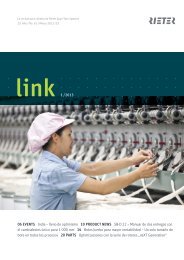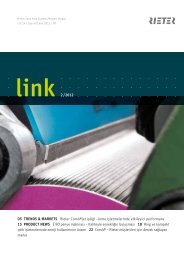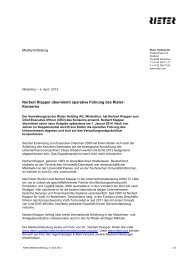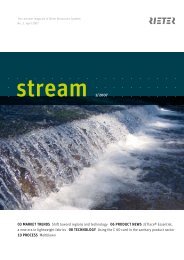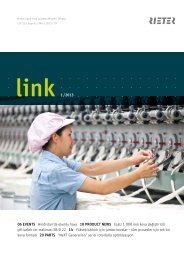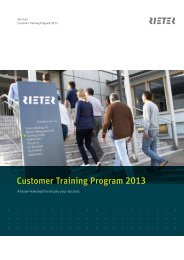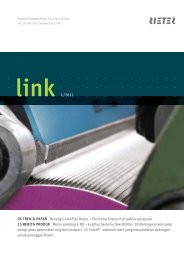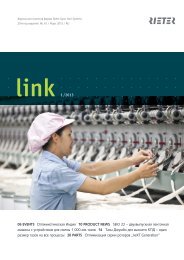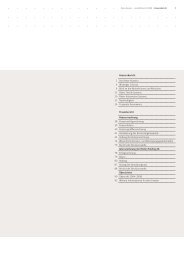Create successful ePaper yourself
Turn your PDF publications into a flip-book with our unique Google optimized e-Paper software.
4 <strong>Rieter</strong> . <strong>LINK</strong> 52 . 1 /2008<br />
TECHNOLOGY<br />
Processing SPV viscose using <strong>Rieter</strong><br />
R 40 rotor spinning technology<br />
The combination of SPV viscose fibers with <strong>Rieter</strong> R 40 rotor spinning<br />
technology enables rotor speeds of 130 000 rpm and delivery speeds of<br />
175 m/min to be achieved with Ne 30/1 yarns while maintaining very<br />
good running properties and optimum yarn structure for downstream<br />
processing of the yarn. The twist factor for processing SPV viscose is<br />
ideally within the αm 100-110 range. A mean twist factor of αm 105 can<br />
be recommended for weaving and knitting applications.<br />
Fig. 1 Moisture<br />
distribution in the<br />
cross-section of the<br />
different cellulose<br />
fibers.<br />
Source: Autex Textile<br />
Conference 2005.<br />
1. Cotton<br />
2. TENCEL®<br />
3. Modal<br />
4. Viscose<br />
Alternative to cotton<br />
Cellulose fibers such as viscose, Modal and Tencel®<br />
are very good alternatives to cotton and play a major<br />
role on the textile market, especially for fashionable<br />
clothing, bed linen, towels and underwear.<br />
Raw materials made from cellulose are even better<br />
than cotton in certain clothing functions, for example<br />
softness and antibacterial properties. Cellulose<br />
is therefore either blended with cotton or used<br />
100% in clothing that comes into direct contact with<br />
the skin. In the case of extremely high functional requirements,<br />
multi-component textile fabrics can also<br />
1 2<br />
3 4<br />
be called for. The use of two-ply weaves in different<br />
raw materials is a trend-setting feature here. A combination<br />
of different knitted or woven fabrics can be<br />
of advantage in leisurewear and sportswear, where<br />
dealing with body perspiration is an important aspect.<br />
The skin can be prevented from cooling off if<br />
body moisture is absorbed by the viscose/cotton<br />
blend and transported into the atmosphere through<br />
the polyester surface. The polyester surface also protects<br />
the skin against external environmental influences.<br />
Properties of cellulose fibers<br />
Cellulose fibers have the best antibacterial properties<br />
compared with polyamide, polyester, polypropylene<br />
and cotton. They also absorb moisture very<br />
readily and distribute it very effectively, depending<br />
on type. For example, Tencel® absorbs as much as<br />
50% more moisture than cotton.<br />
Moisture distribution is illustrated by the adjoining<br />
photographs, in which the dark areas indicate moisture<br />
and the light areas the fiber raw material. In the<br />
case of Tencel® it is apparent that moisture distribution<br />
occurs over a very wide area and that moisture<br />
is absorbed very uniformly compared with cotton<br />
(Fig. 1).<br />
High-performance spinning<br />
In addition to the major advantages of cellulose fibers<br />
in the garment industry, the type of viscose and<br />
the spinning process, such as ring, rotor or air-jet,<br />
and the optimum machine configuration play a crucial<br />
role. Ultimately, these parameters are decisive<br />
not only for the properties of the textile product, but<br />
also the economics of yarn manufacture.<br />
Test parameters<br />
A 1.3 dtex SPV viscose with 38 mm cut staple was<br />
used, together with another Asian viscose with the<br />
same specifications for comparison. These were<br />
processed on the latest <strong>Rieter</strong> high-performance machines:<br />
• C 60 card<br />
• SB-D 15 drawframe<br />
• RSB-D 40 drawframe<br />
• R 40 rotor spinning machine.


